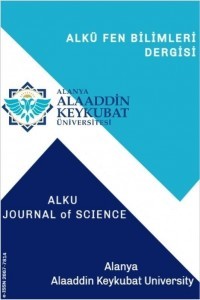EFFECT OF FLY ASH AND ITS CURING TIME ON SPECIFICATION OF FLY ASH – SILTY SOIL MIXTURE
fly ash, curing time, internal friction angle
EFFECT OF FLY ASH AND ITS CURING TIME ON SPECIFICATION OF FLY ASH – SILTY SOIL MIXTURE
fly ash, curing time, internal friction angle,
___
- [1] Leonards, G. A., Cutter, W. A., Holtz, R. D., (1980), “Dynamic Compaction of Soils”. Journal of the Geotechnical Engineering Division, ASCE, Vol.106, No , 35-44.
- [2] Erol, B., (2008), “Atık Maddelerin Yol İnşaatlarında Temel Malzemesi Olarak Kullanımı,” İstanbul Teknik Üniversitesi, Fen Bilimleri Enstitüsü, Yüksek Lisans Tezi, İstanbul.
- [3] Önalp, A., (2012), “Geoteknik Bigisi”, 3.baskı, Birsen Yayınevi, Istanbul.
- [4] TS 639, (1975), Uçucu Küller - Çimentoda Kullanılan, Türk Standartları Enstitüsü, Ankara.
- [5] Güler, G., Güler, E., Đpekoğlu, Ü., Mordoğan, H., (2005), Uçucu Küllerin Özellikleri ve Kullanım Alanları , Türkiye 19. Uluslararası Madencilik Kongresi ve Fuarı, İzmir.
- [6] Öner, A., (2005), Uçucu Kül ve Öğütülmüş Yüksek Fırın Curufu Đçeren Betonların Mekanik ve Durabilite Özellikleri Açısından Optium Bileşiminin Belirlenmesi, Doktora Tezi, Kocaeli Üniversitesi Fen Bilimleri Enstitüsü, Kocaeli.
- [7] Şengül, Ö., Taşdemir, M.A., Sönmez, R., (2005), Yüksek Oranda Uçucu Kül Đçeren Normal ve Yüksek Dayanımlı Betonların Klor Geçirimliliği, Đ.M.O. Bülten, Sayı:77.
- [8] Atakay, O., (2006), Uçucu Küllerin Katkılı Çimento Katkılı Çimento Üretiminde Kullanılması – Tane Đnceliği ve Katkı Miktarının Etkisi, Yüksek Lisans Tezi, Hacettepe Üniversitesi Fen Bilimleri Enstitüsü, Ankara.
- [9] Brooks, R.M., (2009), “Soil Stabilization With Flyash And Rice Husk Ash” International Journal of Research and Reviews in Applied Sciences ISSN: 2076-734X, EISSN: 2076-7366 Volume 1, Issue 3
- [10] Nazaroghlu M.B, Dehghanian K, (2019), “Study on the Mechanical Properties of Clay- Fly Ash Mixture” International Journal of Engineering Research & Technology (IJERT), Vol 8, Issue 6.
- [11] Amadi, 2010 A.A. AmadiEvaluation of changes in index properties of lateritic soil stabilized with fly ash
- [12] ASTM C618-19. Standard Specification for Coal Fly Ash and Raw or Calcined Natural Pozzolan for Use in Concrete, ASTM International, West Conshohocken, PA, 2019.
- [13] TS 1500. İnşaat Mühendisliğinde Zeminlerin Sınıflandırılması. Türk Standardları Enstitüsü, Ankara, 2006.
- [14] TS 1900-1. İnşaat Mühendisliğinde Zemin Lâboratuvar Deneyleri - Bölüm 1: Fiziksel Özelliklerin Tayini. Türk Standardları Enstitüsü, Ankara, 2006.
- [15] TS 1900-2. İnşaat Mühendisliğinde Zemin Lâboratuvar Deneyleri - Bölüm 2: Mekanik Özelliklerin Tayini. Türk Standardları Enstitüsü, Ankara, 2006.
- [16] Yılmaz I, Yıldırım M, Keskin I. Zemin Mekaniği Laboratuvar Deneyleri ve Çözümlü Problemler, 2.baskı Ankara, Türkiye, Seçkin, 2014.
- Yayın Aralığı: Yılda 3 Sayı
- Başlangıç: 2019
- Yayıncı: Alanya Alaaddin Keykubat Üniversitesi
EFFECT OF FLY ASH AND ITS CURING TIME ON SPECIFICATION OF FLY ASH – SILTY SOIL MIXTURE
Kaveh DEHGHANİAN, Najibullah AYAR
Sivas İlindeki Bir Bina İçin Enerji Simülasyonunun Uygulanması
COBALT BORİD KATALİZÖRLERİ İLE SODYUM BOROHİDRİTTEN HİDROJEN ÜRETİMİ
Sevim YOLCULAR KARAOĞLU, Serdar KARAOĞLU
Pirinç Kabuğu Külü Katkılı Harçların Dayanım Ve Dayanıklılık Özelliklerin Araştırılması
Doğaltaş Üretim ve İşleme Tesis Atıklarının Değerlendirilmesi
